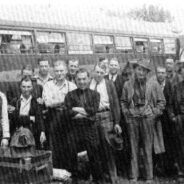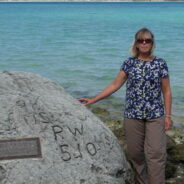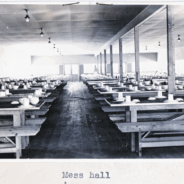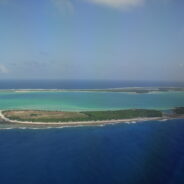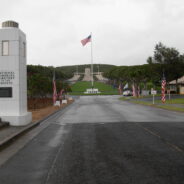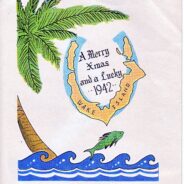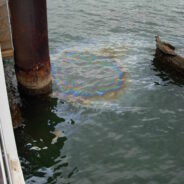Draw It, 1941
Drawings may look simple on the surface, but they convey complex messages about both the subject and the person making the drawing. During my research for Building for War I encountered many line drawings from 1941: some were professional and purposeful, others were personal sketches found in letters and diaries. I found them as revealing as the written primary sources on which I based much of the book, but only one made it into the published book (a map of Wake, sketched by my grandfather in a letter. The Wake maps are fascinating and occupy...
read moreThe Northwest Connection
The Depression-era workers who hired on for the big prewar navy construction projects in the Pacific came from many states, but a good number hailed from the Pacific and Inland Northwest. In 1939-40 the navy contracted with a consortium of big construction companies to build naval air stations and facilities on Oahu, Palmyra, Johnston, Midway, and Wake Island (and later in the western Pacific at Guam, Cavite in the Philippines, and American Samoa). One of the eight contracting companies was Morrison-Knudsen Company, headquartered in Boise,...
read moreThe Wake 98
Every few weeks I write a post to highlight the ongoing mission of the Joint POW-MIA Accounting Command (JPAC) to locate family members of the 98 men massacred on Wake Island in 1943 for possible DNA matches. For more information, see my November 2012 post on the JPAC Mission. This week I want to talk about the nearly 100 men who drew their last breath on the north beach of Wake, October 7, 1943. When the Tachibana Maru pulled away from Wake Island on September 30, 1942, it sailed for Japan carrying 265 American civilian prisoners of war –...
read moreWake Island Birds
Wake’s human population may be small these days, but the neighborhoods are full to bursting with birds (see video link below!). The remote, isolated atoll has hosted a wide variety of migratory and resident seabirds for time out of mind. The ravages of the WWII Japanese occupation and postwar feral cat predation left indelible marks, but researchers are encouraged by signs of robust recovery across the atoll. During my visit to Wake in the fall of 2011 I was captivated by the graceful white terns that would appear from the trees on Wake and...
read moreThe Old “Color Line”
If you had looked in the mess hall on Wake Island at dinner time on any given day in 1941, you would have seen a sea of white faces. Some bore dark tans from hours in the tropical sun, but most were Caucasian except for a few Pacific Islanders and a couple dozen Chinese Americans. The “color line” was a wall against equal opportunity: preferential hiring, segregation of workers, and ethnic biases were entrenched in the construction camps and defense factories in the prewar period. In June 1941, A. Philip Randolph, prominent...
read moreWilkes
Wilkes Island, the southwest arm of Wake atoll, bears a wartime scar that may never heal. Halfway along the lagoon side the shore juts sharply inward, nearly bisecting Wilkes. Only a narrow strip of land remains, cluttered with concrete blocks and nearly submerged at high tide, to connect to the western end. The indentation may appear natural to the casual observer but folks familiar with Wake and its history know that it is “man-made.” The altered coastline is visible on every map and aerial photograph of Wake – even the one from the...
read moreHonor in Death
No straight road leads to the National Memorial Cemetery of the Pacific in Honolulu. Winding up the narrow streets past modest houses and bright splashes of bougainvillea you only know that if you are still ascending your destination is surely ahead. At the top the Punchbowl opens up wide, a cemetery like no other, dedicated to those who lost their lives in World War II in the Pacific and the Korean and Vietnam Conflicts. Puowaina Crater, once the site of royal Hawaiian burials and sacrifices, is now the final resting place of tens of...
read moreChristmas 1941
Many Wake Island men sent cards and holiday gifts by ship’s mail in late November 1941, timed to reach loved ones at home just before the upcoming Christmas holiday. Some of the fellows reached deeper into their pockets to pay airmail rates and sent their cards on the eastbound Pan American Clipper. Despite the war clouds gathering over the Pacific, few on Wake worried that anything would hold up the mail unless Mother Nature cooked up another typhoon in the neighborhood. The Wake “multigraph” machine churned out cheery cards for employees to...
read morePan American
Pan American Airways was the first to establish a permanent settlement on Wake Island. Late in 1934 the commercial airline obtained permission from the U.S. government to build stations on Wake and Midway Islands for its transpacific Clipper operation. Protected lagoons offered calm waters for seaplane runways, though divers would have to blast many coral heads and shelves for safe depths. When operational the mid-Pacific stations would provide vital links in the chain linking the West Coast and Asia. The North Haven, Pan American’s supply...
read moreLiving in Infamy
December 7 carries a big burden. President Roosevelt had it right: this date lives in infamy. For Americans it will always be associated with the horrific Japanese attack on Pearl Harbor in 1941. Every year on this day solemn ceremonies honor the lives lost and the irreversible descent into World War II. The hard-hit Pacific Fleet base at Pearl Harbor carries the banner, although the Japanese also targeted numerous other military installations on Oahu and across the Pacific, including Wake Island. Infamy is a loaded word: it conjures up a...
read more


